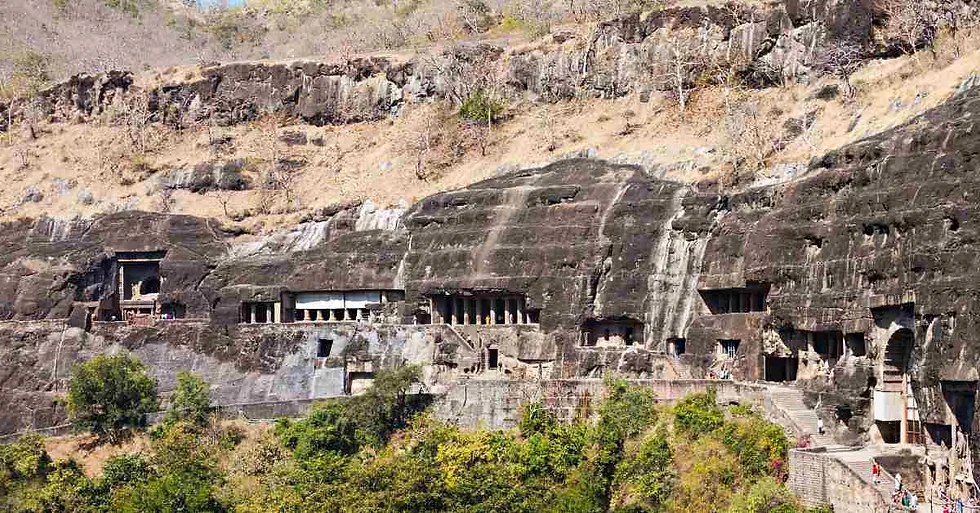India, a land steeped in history and culture, is home to some of the most remarkable architectural and artistic achievements in the world. Among these are the Ajanta and Ellora Caves, UNESCO World Heritage Sites that showcase the genius of ancient Indian artisans and their profound spirituality. Nestled in the state of Maharashtra, these caves offer a glimpse into the artistic, religious, and cultural developments of ancient India. In this blog, we will explore the history, significance, and attractions of these two extraordinary sites.
1. The Ajanta Caves: A Marvel of Ancient Art
Overview
The Ajanta Caves, a series of 30 rock-cut caves, are located in the Sahyadri hills near the town of Ajanta, about 100 kilometers from Aurangabad. Dating back to the 2nd century BCE to the 6th century CE, these caves are renowned for their stunning murals and intricate sculptures that depict Buddhist teachings and stories.
Historical Significance
Buddhist Influence: The caves were primarily used as monastic quarters by Buddhist monks and served as a center for meditation and teaching. They played a crucial role in the spread of Buddhism across India and beyond.
Rediscovery: The caves were forgotten for centuries until they were rediscovered in 1819 by a British officer, John Smith, during a hunting expedition. Since then, they have become a vital part of India’s cultural heritage.
Key Attractions
Cave 1: This cave features exquisite frescoes and a large chaitya (prayer hall) with a stupa at its center. The intricate murals depict scenes from the life of the Buddha and Jataka tales.
Cave 2: Known for its impressive paintings and elaborate carvings, this cave includes depictions of celestial beings and the Buddha in various postures.
Cave 16: The most famous of the Ajanta Caves, Cave 16 houses a massive statue of the reclining Buddha and showcases stunning rock-cut architecture.
Frescoes: The paintings in the Ajanta Caves are celebrated for their vibrant colors and detailed depiction of human emotions, nature, and Buddhist philosophy.
Cultural Experience
Guided Tours: Exploring the caves with a knowledgeable guide can enhance your understanding of the history and significance of the artwork.
Photography: While photography is restricted inside the caves, the breathtaking views of the surrounding landscape are perfect for capturing memories.
2. The Ellora Caves: A Confluence of Religions
Overview
The Ellora Caves, located about 30 kilometers from Ajanta, comprise 34 rock-cut caves dating from the 5th to the 10th centuries CE. Unlike Ajanta, which is primarily Buddhist, Ellora showcases a remarkable blend of Hindu, Jain, and Buddhist traditions, making it a symbol of India’s religious tolerance.
Historical Significance
Architectural Achievement: The caves are remarkable for their monumental rock-cut architecture, with intricate carvings and sculptures that reflect the artistic prowess of ancient Indian craftsmen.
Cultural Harmony: The presence of caves dedicated to different religions within such close proximity highlights India’s history of cultural synthesis and coexistence.
Key Attractions
Kailasa Temple (Cave 16): The crown jewel of the Ellora Caves, this massive monolithic structure is dedicated to Lord Shiva. Carved from a single rock, the temple features elaborate sculptures, intricate pillars, and a majestic representation of Mount Kailash.
Cave 10: Known as the Chaitya Hall, this cave features a large stupa at its center and is adorned with beautiful sculptures and frescoes depicting Buddhist themes.
Cave 29 (Jain Cave): This cave is notable for its stunning carvings and sculptures dedicated to Jain Tirthankaras. The intricate detailing and serene ambiance make it a must-visit.
Cave 21 (Hindu Cave): This cave contains beautiful sculptures of Hindu deities and scenes from Hindu mythology, showcasing the artistic diversity of Ellora.
Cultural Experience
Festivals: The Ellora caves are vibrant during festivals, particularly during the Kailash Festival in March, which celebrates the artistic heritage of the region.
Local Cuisine: Nearby Aurangabad is known for its delicious cuisine. Don’t miss trying the local delicacies, including the famous Aurangabad biryani and mawa jalebi.
3. Planning Your Visit
Best Time to Visit
Ajanta Caves: The best time to visit is between October and March when the weather is pleasant and conducive for exploration.
Ellora Caves: Similar to Ajanta, the winter months are ideal for visiting Ellora, with comfortable temperatures for outdoor activities.
Getting There
By Air: The nearest airport is Aurangabad Airport, well-connected to major Indian cities.
By Train: Aurangabad is the nearest railway station, with regular trains from cities like Mumbai, Pune, and Delhi.
By Road: Both Ajanta and Ellora are accessible by road, with several local transport options available from Aurangabad.
Tips for Travelers
Wear Comfortable Shoes: The caves require a fair amount of walking and climbing, so wearing comfortable shoes is essential.
Stay Hydrated: Carry water, especially during warmer months, as exploring the caves can be tiring.
Respect the Art: While photography is allowed in some areas, be mindful of the rules and respect the sanctity of these historical sites.
Conclusion: A Journey Through Time
The Ajanta and Ellora Caves stand as testaments to India’s rich cultural heritage and artistic brilliance. They offer a unique opportunity to explore ancient history, spiritual philosophy, and artistic creativity that flourished in this region centuries ago.
Visiting these caves is not merely a tour of architectural wonders; it’s a journey through time, where each carving and painting tells a story of devotion, creativity, and cultural diversity. Whether you’re an art enthusiast, a history buff, or a spiritual seeker, Ajanta and Ellora promise an unforgettable experience that captures the essence of India’s ancient wonders.









